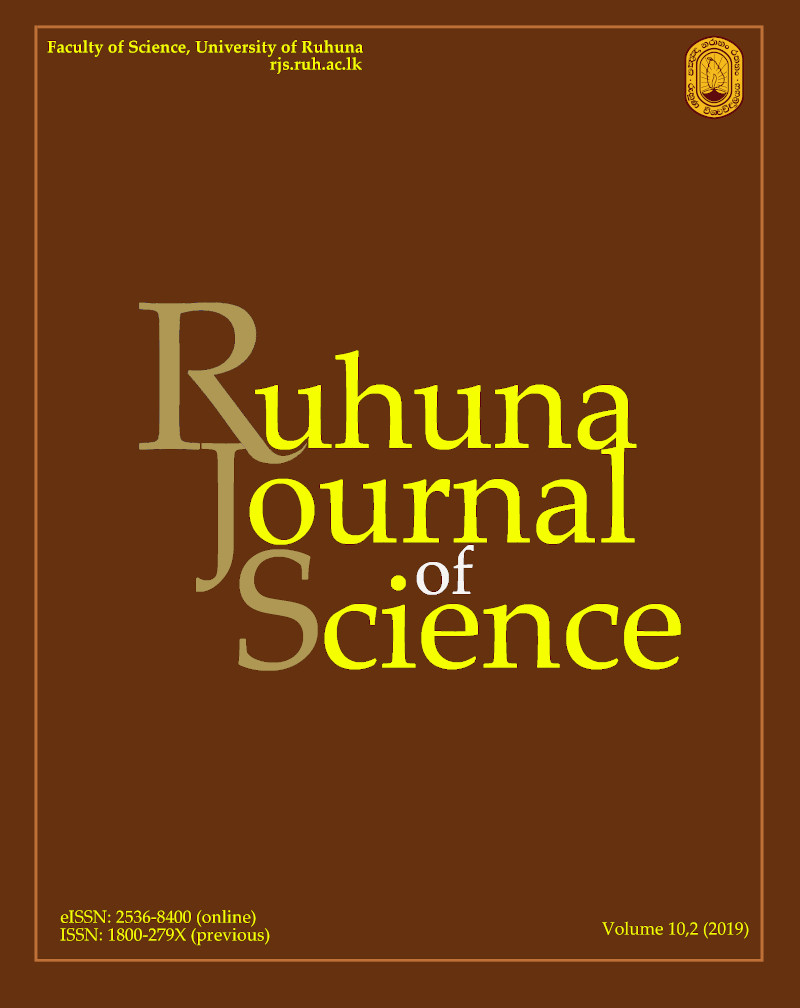Application of Lagrange equations to 2D double spring-pendulum in generalized coordinates
Abstract
In this study, the Lagrange’s equations of motion for a 2D double spring-pendulum with a time-dependent spring extension have been derived and solved approximately. The resulting equations are also solved numerically using Maple, and plots of motion for the pendulum bobs m1 and m2 are presented and compared. It was observed that motion along the x-axis is characterized by sine wave function while motion along y-axis is characterized by cosine wave function with slightly changing amplitudes. Change in stiffness constant, angle of deflection, mass of pendulum bob and spring length were found to have significant effect on the dynamics of the double spring-pendulum. The periodic and chaotic behaviour noticed in this study is consistent with current literature on spring-pendulum systems. Keywords: Lagrange equations, double spring-pendulum.References
Baleanu D, Asad, JH, Petras I. 2015. Numerical solution of the fractional Euler- Lagrange’s equations of a thin elastic model. Nonlinear Dynamics 81: 97-102. https://doi.org/10.1007/s11071-015-1975-7
Biglari H, Jami RA. 2016. The double pendulum numerical analysis with Lagrangian and the Hamiltonian equations of motions. Conference paper: International conference on mechanical and aerospace engineering. pp 1-12. https://www.researchgate.net/publication/ 301890703
Carretero-Gonzalez R, Nunez-Yepez NH, Salas-Brito LA. 1994. Regular and chaotic behaviour in an extensible pendulum, European Journal of Physics 15: 139. https://doi.org/10.1088/ 0143-0807/15/3/009
de Sousa MC, Marcus FA, Caldas IL. 2017. Energy distribution in spring pendulum. Nonlinear Optics 4: 6.
Goldstein H, Poole C, Safko J. 2000. Classical mechanics, 3rd edn. Addison Wesley, New York, 5-69.
Leah G. 2013. The Swinging Spring: Regular and Chaotic Motion. http://depts.washington.edu/ amath/wordpress/wp-content/uploads/2014/01/leah_ganis_pres.pdf
Lewin A, Chen P. 2015. Numerical analysis of dynamics of single and double spring pendulum systems. https://www.math.dartmouth.edu/~m53f15/proj/chenlewin.pdf
Maple 2018. Maplesoft, a division of Waterloo Maple Inc., Waterloo, Ontario.
Marcus FA, de Sousa MC, Caldas IL. 2016. Order-chaos-order transition in a spring pendulum, 6th International Conference on Nonlinear and Complexity, National Institute for Space Research, Brazil, May 16-20.
Martin C, Salomonson P. 2009. An introduction to analytical mechanics, 4th edn. Goteborg Sweden 1-62 pp.
Murray RS. 1967. Theoretical mechanics, Schaum’s outlines, Mcgraw-Hill 299 – 301 pp.
Nunez-Yepez NH, Salas-Brito LA,Vicente L. 1990. Onset of Chaos in an Extensible Pendulum. Physics Letters A 145:101–105. https://doi.org/10.1016/0375-9601(90)90199-X
Smith RA. 2002. Numerical solution of equations of motion for double pendulum, Maple document Application center.1-5 pp.
Downloads
Published
Issue
Section
License
From Volume 7 (2016) onwards, all articles published in Ruhuna Journal of Science are Open Access articles published under the Creative Commons CC BY-NC 4.0 International License. This License permits use, distribution and reproduction in any medium, provided the original work is properly cited and is not used for commercial purposes.
Copyright on any research article published in RJS is retained by the respective author(s).
Authors who publish with this journal agree to the following terms:
a) Authors retain copyright and grant the journal right of first publication with the work simultaneously licensed under a Creative Commons Attribution License CC-BY-NC 4.0 International, that allows others to share the work with an acknowledgement of the work's authorship and initial publication in this journal.
b) Authors are able to enter into separate, additional contractual arrangements for the non-exclusive distribution of the journal's published version of the work (e.g., post it to an institutional repository or publish it in a book), with an acknowledgement of its initial publication in this journal.
c) Authors are permitted and encouraged to post their work online (e.g., in institutional repositories or on their website) prior to and during the submission process, as it can lead to productive exchanges, as well as earlier and greater citation of published work (See The Effect of Open Access).

